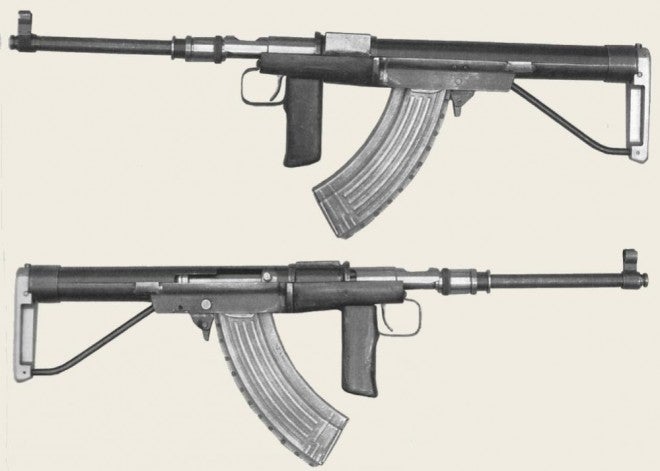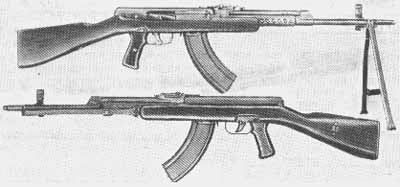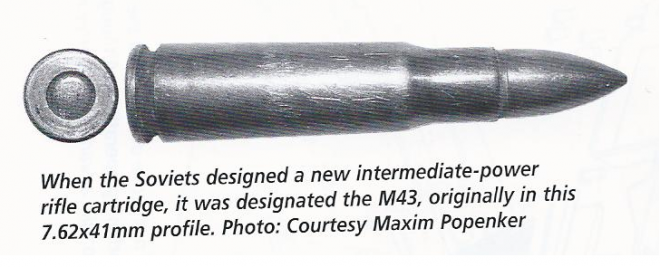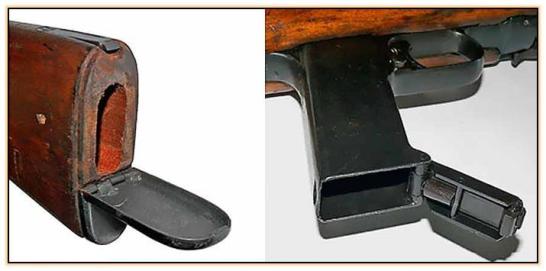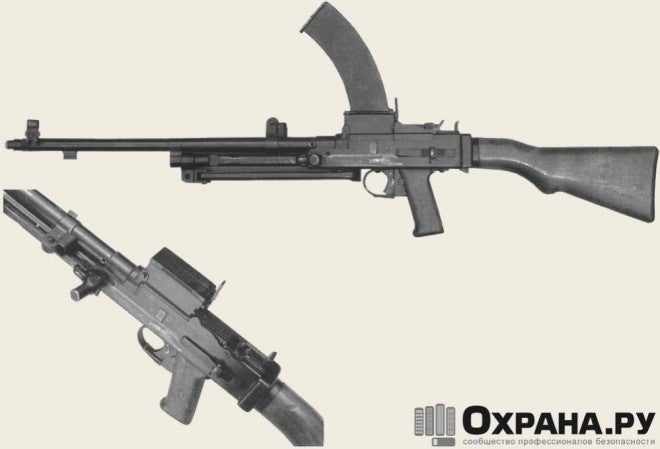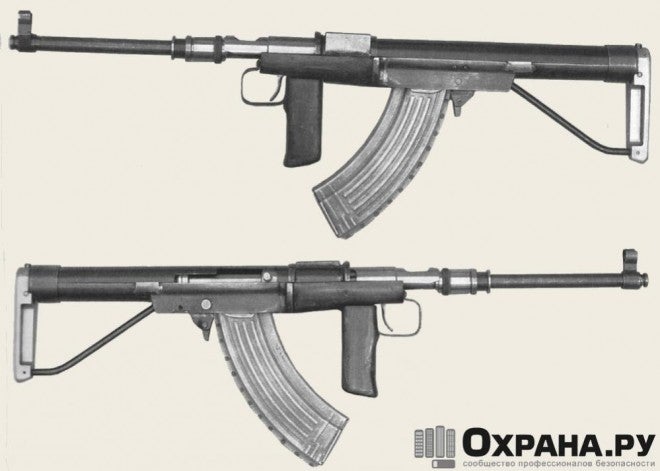While it’s well known that the Germans were the first to field select-fire assault rifles in large numbers during World War II, the Soviets, thoroughly impressed by the idea of an intermediate-power infantry cartridge and intrigued by the idea of the assault rifle, were hot on the Germans’ heels with as many as nine different kinds of prototype assault rifles completed before the end of of the war. Each of these weapons were developed by talented and accomplished Soviet arms designers, and offer a glimpse into the genesis of the Russian assault rifle program that would eventually result in the world-famous Kalashnikov “AK-47” rifle, the most-produced weapon of its kind in history.
To complete this article, I have had to rely heavily on the Russian-language articles written by Alexander at his excellent blog Armory Exotic. Because I do not speak or read much Russian, my information is coming via the imperfect means of machine translation. I will reference each article in the respective segment of the weapon it describes, and would greatly appreciate hearing from our Russophone readers any corrections to errors I may have made with regard to this article’s factual correctness. In addition, I found a wealth of relatively high-resolution photos hosted over at the Ohrana.ru forums, including several models of prototype Soviet assault rifles I do not cover in this post.
All nine of the rifles below would have been chambered in the Soviet 7.62x41mm M43 intermediate cartridge, the predecessor to the now-familiar 7.62x39mm round of the AK and SKS series of rifles.
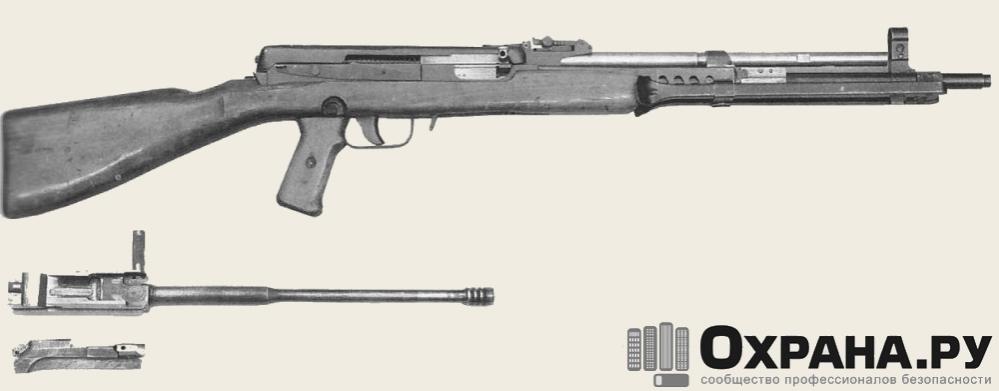
The Sudaev AS-44 rifle. Note the tilting bolt. This appears to be a fourth model, though I am not sure. Image source: forum.ohrana.ru
The assault rifle designed by Alexei Sudaev is easily the best-known Soviet assault rifle of the Second World War, and the most successful, as well. However, it’s still quite obscure, despite being produced for field trials just after the conclusion of the war in Europe. In my article Ten 20th Century Military Rifles History Has Forgotten, I wrote the text below about the AS-44:
One of the most interesting forgotten rifles of World War II, the Sudaev AS-44 was a limited production assault rifle that saw service in 1945 in troop trials just after the victory in Europe. The AS-44 was chambered for the new 7.62x41mm cartridge – the predecessor to the highly successful 7.62x39mm Soviet intermediate cartridge, which arose as a modification to allow the design to use steel-cored projectiles. Like the MP.44, Ribeyrolle CM 1918, and many other early assault rifle designs, the AS-44 was heavy, at around 11 pounds unloaded.
The AS-44 used the highly successful tilt-locking bolt pioneered by the Czechs in the ZB 26 machine gun, and also used in the MP.44, coupled – also like the MP.44 – to a fixed piston similar to that later used in the AK rifle.
Sudaev’s rifle was promising, but by 1945 Sudaev himself had fallen severely ill, and he died the next year. While development of his rifle ceased, elements were carried forward in the Kalashnikov assault rifle design, which became the world-famous AK rifle.
In fact, seven models of the AS-44 existed, the first six representing incremental improvements to the design which are covered in the Armory Exotic article linked above. The seventh model, however, was a modified version of the fourth model that utilized a gas-delayed blowback mechanism similar to that used in the Heckler & Koch P7, the Walther CCP, and the Gustloff last-ditch carbine. The AS-44 was a very heavy weapon; the first model with integral bipod weighed almost twelve and a half pounds unloaded (it’s unknown whether that’s with an empty magazine or not). His rifles were determined to be reliable weapons in tests, but they were considered too heavy and not as accurate as the existing Mosin rifle. Development ended when the middle-aged Sudaev suddenly fell ill in 1945 and died in 1946. Sudaev’s weapon may have left a lasting mark on the small arms world, however, as it appears the magazine pattern common today because of the AK series of rifles was derived from Sudaev’s design.
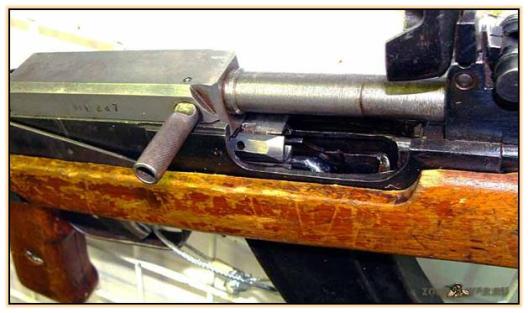
An AS-44, which may be a fourth model, showing the tilting bolt, carrier, and fixed gas piston of the design. Note the hinged dust cover, which would be re-incorporated into Soviet assault rifle design with the AKS-74U compact weapon. Image source: raigap.livejournal.com.
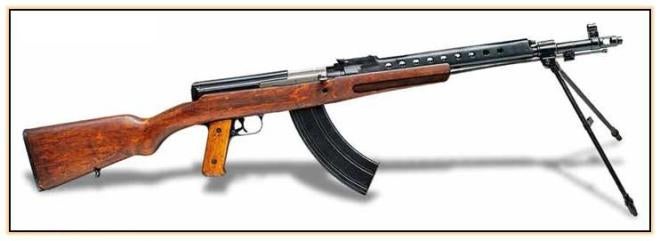
The AT-44, bipod deployed. Note the bipod feet with optional folding stake-ends. Image source: raigap.livejournal.com
In what can only be described as a logical step from his AVT-40 select-fire 7.62x54mmR rifle design, Soviet designer Fedor Tokarev developed beginning in October of 1943 (by which point g. Tokarev was in his seventies) an assault rifle of the same basic design, in the brand-new 7.62x41mm M43 caliber. Development was conducted in Nudelman’s OKB-16 bureau in Moscow, and the rifle was complete and submitted for testing by May 7th of 1944.
The AT-44 was mechanically nearly identical to the AVT-40 that preceded it, the latter simply being a select-fire variant of the SVT-40 rifle that was produced in some numbers. This, plus his political connections, gave Tokarev a considerable lead in development over other designers. The AT-44 utilized a gas regulator mounted to an integrated unit providing the gas block, front sight, muzzle brake, and bayonet lug. Versus the SVT-40, it had a shorter receiver, smaller bolt face, relocated trigger (to accommodate a pistol grip), and a selector lever located on the lower rear portion of the trigger guard. The automatic fire mechanism of the AT-44 was very simple, with the position of the trigger itself determining semi- or fully-automatic fire.
The rifle additionally incorporated a folding bipod with folding stake-end feet, allowing use on either hard or soft ground. With this bipod, the rifle weighed ten and a half pounds. Interestingly, the design also incorporated trapdoor compartments on both the buttstock and bottom of the pistol grip, the latter being a feature that wouldn’t become popular again until the 21st Century.
Ultimately, the AT-44’s conservatism was its undoing, as the rifle failed in tests, and the fundamental design was considered too poor to warrant further development. This feeling was shared for the rifle’s bigger brother, the SVT-40, which was so poorly received that production was stopped in mid-1943.
Much less information is known about the following three weapons than the preceding two:
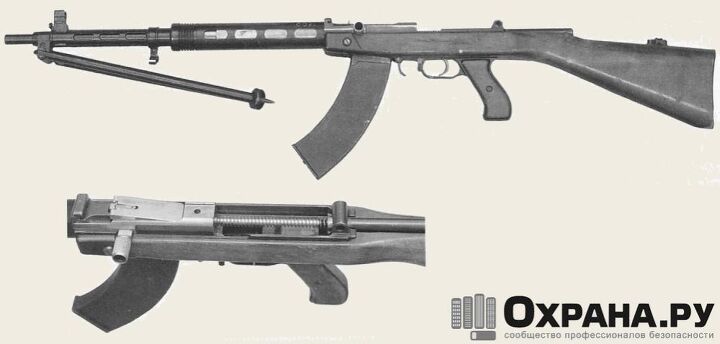
The Korovin AK-44, apparently missing its receiver cover. The annular piston appears to be visible under the handguards. Note the bipod, a Soviet requirement at the time. Image source: forum.ohrana.ru
Korovin’s design appeared to use tilt-locking of some variety, with an action powered by an annular gas piston (a design that would crop up again on the Czech vz. 52 rifle). The weapon was, apparently, fully automatic only, though perhaps that was just because it was a developmental model. Interestingly, Korovin may have had the most experience designing assault rifles, as a rifle bearing his name and probably chambered for the American .351 WSL cartridge is known to have been made in 1933.
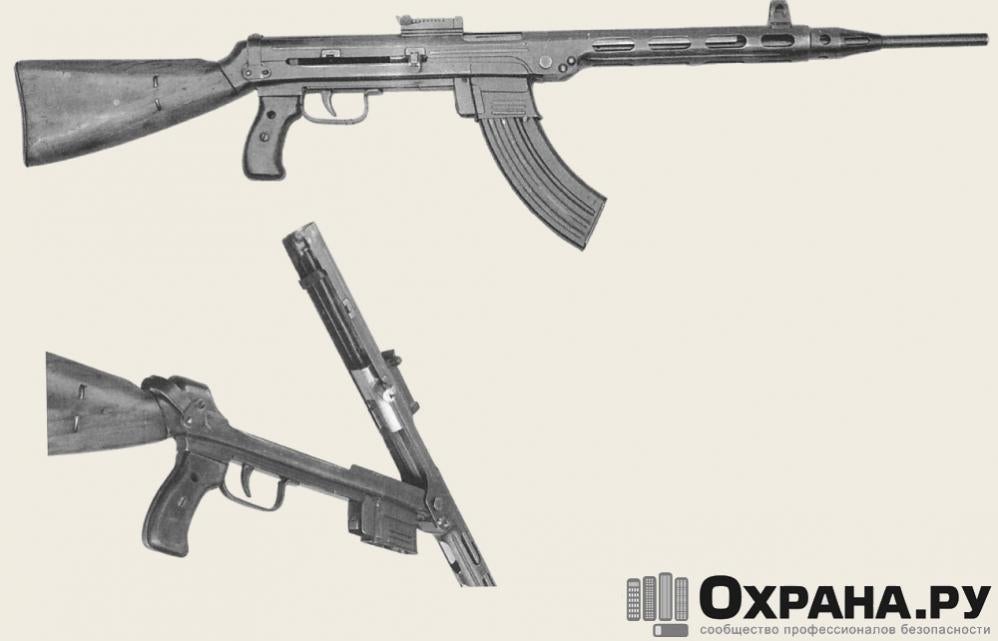
The Shpagin assault rifle, AS-44. This was a straight-blowback design, and was quickly shown to be unsuccessful. Inset: The AS-44, with receiver “shotgunned” open to show the moving parts. Image source: forum.ohrana.ru
Georgy Shpagin, designer of the famous PPSh-41 submachine gun, and co-designer of the 12.7mm DShK heavy machine gun, also developed a rifle for the trials before the end of the war. His weapon was an attempt to directly translate the PPSh-41’s design into an intermediate assault rifle, and was unsuccessful. The weapon’s unlocked, straight blowback breech resulted in a very heavy moving mass, and very violent action that spoiled the weapon’s controllability. After only 315 rounds fired, the Shpagin assault rifle was dropped from the competition. However, his design led to a mandate that all further Russian assault rifle designs trialed must be have some kind of breech locking mechanism.
The translation is difficult to read on how the AB-44 worked, but it appears that the design was intended to minimize the number of machined components needed by offloading the locking pressure to the front of the receiver, a design element that would be repeated in Bulkin’s later AB-46 rifle, and incorporated into Kalashnikov’s AK-46 and AK-47 rifles. To do this, it seems the rifle used a camming, rotating bolt riding in swept locking surfaces, operating the gun via retarded blowback. The AB-44 is the most unusual looking weapon of those covered in this article, taking more of its cues in appearance from light machine guns of the time than submachine guns or assault rifles.
The AB-46, a more traditional rifle also designed by Bulkin, would become one of the front-runners in the Soviet Union’s assault rifle program, and heavily influenced the design of the successful Kalashnikov AK-47 rifle.
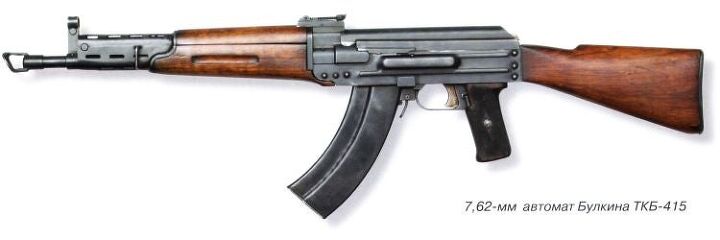
The Bulkin AB-46. Even from this photo, the design’s influence on the Kalashnikov is clear. Image source: gunandgame.com
Korovin AK-45
Sources put this rifle as dating from either 1945 or 1946, while the weapon appears in photos with a later-pattern AK magazine, suggesting that somehow the two used compatible magazine patterns. The weapon used a bullpup layout which was extremely innovative at the time, and utilized duralumin for the buttplate and magazine. The latter was very significant, as it would have substantially reduced the weight of ammunition carried on the soldier, and indeed the Czechs put this idea into practice with the vz. 58 rifle. The AK-45 failed initial range tests.
Finally, for the following rifles I do not even know enough about to write descriptions. I know only the names of the designers, and what can be seen from the photos. However, all are equipped with bipods, which was dropped as a requirement before 1946, which suggests to me that they were all developed during World War II, or shortly thereafter:
Alexandrovich and Ivanov Avtomat
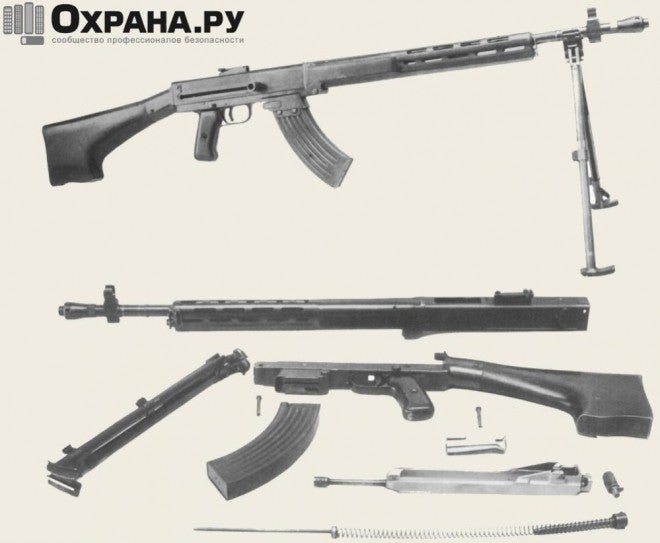
The Alexandrovich and Ivanov avtomat. The pattern of magazine, tilting bolt, and bipod strongly suggest this weapon was developed for the rifle trials at the end of and shortly after WWII, but I do not know that for certain. Image source: forum.ohrana.ru
Alexandrovich and Kashtanov Avtomat
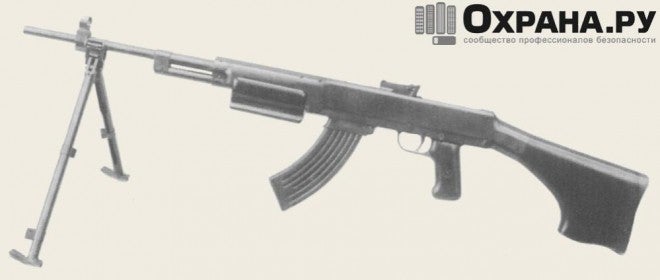
The Alexandrovich and Kashtanov avtomat, apparently a development of the weapon above, judging by its appearance. Image source: forum.ohrana.ru
Kuzmishchev Avtomat
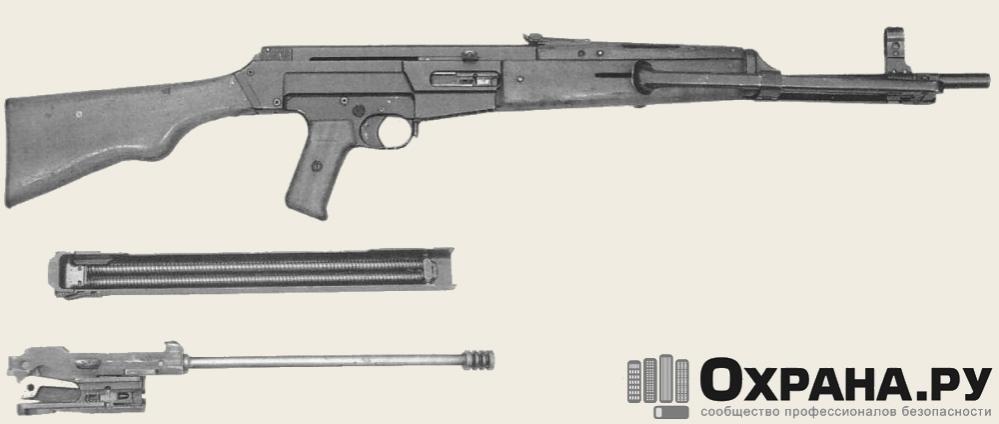
The Kuzmishchev avtomat. The designer of this rifle is referenced as being involved in the early Soviet assault rifle program here, but I have no other evidence that this is an early gun. Still, it mounts a bipod which indicates it may have been. Image source: forum.ohrana.ru
If any of our readers have any more information on any of the weapons covered in this article, please don’t hesitate to let us know.
 Your Privacy Choices
Your Privacy Choices
